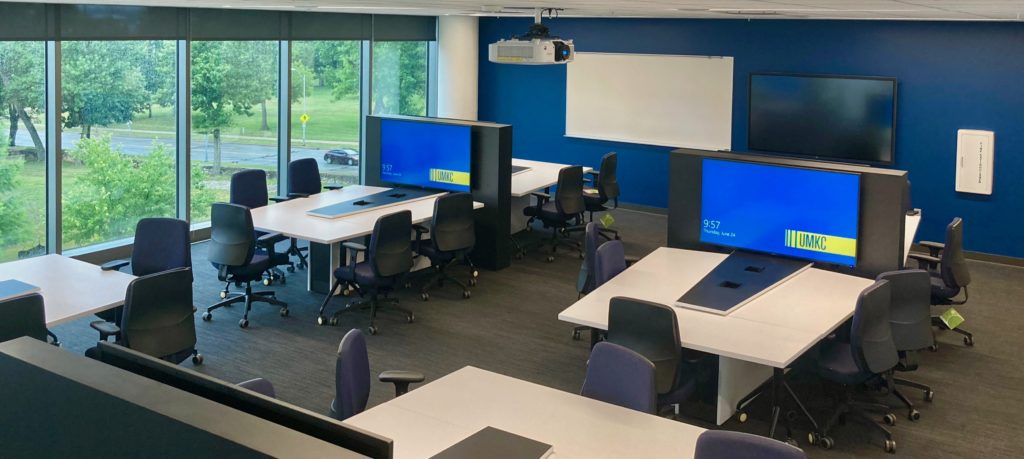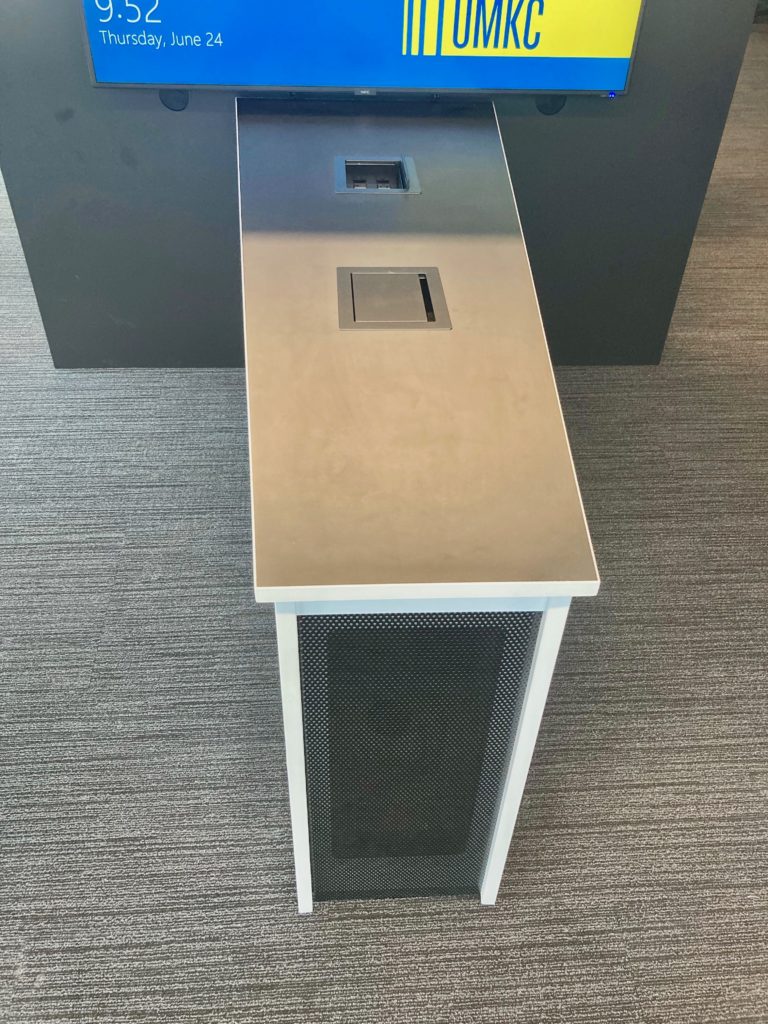In the previous article in this series, we discussed both the criteria we’ll be using to assess the effectiveness of furniture in technology-rich learning environments as well as the categories of furniture we’ll review. We defined technology-enabled furniture as purpose-built to provide dedicated and permanent locations for technology critical to the operation of the learning space, and identified the five criteria for evaluation as standardized connections, equipment mounting, cable routing, field serviceability, and ADA compliance. Please see the Spring 2021 issue of Essentials for more information.
In this article, we’re going to address student tables and workstations. We’ll further refine the definition of student tables and workstations to mean larger, multi-student or shared collaborative workstations that operate as part of a larger classroom AV system. We’re not assessing individual student desks or tables, nor are we discussing independent workstations in standard computer labs or classrooms.
Student tables usually house a large amount of AV technology that serves as both a connection point for individual students as well as a receiving system for content distributed from the instructor or other student groups. This dual-mode operation of the AV equipment is critical to the successful operation of the learning space and is what drives the need to adhere to our identified categories for technology-enabled furniture.

Before looking at the criteria that drive our assessment, we’d like to state at the outset that technology-enabled student tables rarely work when moveable; that is, when designed to be regularly rearranged throughout a space. Sure, there’s lots of power around the room and all the AV and data connections are wireless, right? Not if we can help it. Wireless networking is great for individual devices, but still isn’t reliable enough for commercial AV systems. But what about wireless presentation to the displays around the classroom? Frankly, even the most well-engineered, well-installed, and well-maintained wireless presentation system is almost as good as a basic HDMI cable. Technology-enabled student tables should always be placed in close proximity to floor or wall connections for AV and data. If additional flexibility is necessary, a cable snake can provide some, but no one really likes cables all over the floor, either.
Standardized connections for student tables and workstations refers to the availability of non-proprietary connectors for high voltage, low voltage, data, and AV applications. In addition, the connection locations themselves must be robust enough to support multiple students each supplying multiple devices. Students often bring with them at least two devices (most commonly a smartphone and a laptop), so the table or workstation should be capable of providing power for each of them. In addition to standard NEMA 5-15 110VAC receptacles, modern student tables should also include multiple 5VDC USB-A or USB-C connections for small, portable devices such as smartphones and tablets.
While this may seem like a lot of connections just for power, one of the most common accessories we find added to student tables is a simple power strip or surge protector sitting on the top work surface and, frankly, no one wants that. It’s also worth noting that these power receptacles will almost never be used for the permanently-installed AV devices as our preference is always to have those devices connected to dedicated network-enabled power distribution units, so there’s no need to provide power to locations for AV devices. Any low voltage connections for AV and data will usually be provided as part of the AV scope, so non-proprietary inserts such as keystone, Decora (aka decorator), D-series (aka D-style or D-type), or switchbox gang sizes are a must. Additionally, when considering the amount of power, data, and AV connections we’ve identified, it’s preferable to have multiple table devices (flip-top boxes, pop-up columns, edge-mounted, etc.) than a single large table device or even a central trough.

When it comes to mounting AV equipment on student tables and workstations, much of what we reviewed for lecterns and teaching stations also applies here. Mounting locations should be easily accessible for service and use standardized 19” or 10.5” (aka half-rack) telecommunication rack rail systems. If AV equipment is to be mounted in a single location inside a display support column or in a central wireway column, the location should allow access from multiple sides. Considering that students will be the primary users of the tables, equipment mounting locations should provide a method of securing the equipment behind a latching door or easily-removable panel. The ability to add a keyed lock is a nice option, but not a necessity.
Similarly, cable routing for student tables and workstations has many commonalities with instructor lecterns and teaching tables with the notable exception that student tables contain many more power connections for the aforementioned student-supplied devices. When it comes to wire and cable pathways between AV equipment mounting locations and flip top boxes or pop-up columns for student device connections, more is better. Any intermediate partitions should have the largest passthrough size possible or multiple smaller passthrough locations.
High voltage power cabling and low voltage cables can not share the same cable pathway, so cable routing locations should be sufficiently large enough to separate them by several inches. Dedicated, separate shielded pathways or wireways are always welcome. Student tables are often designed to be placed directly on top of a floor box or against a wall box, but reality never quite works out that nicely, so all AV mounting locations should have multiple access points for cable ingress and egress. If the cable routing is hidden behind panels, they should be easily removable for service and troubleshooting.
To that last point, field serviceability for student tables is a balance between access and security. Local IT staff must be able to quickly and easily access multiple sides of any mounted AV equipment or installed cabling, but at the same time students should be kept out of those same locations. Locking panels are sufficient, if not overkill, whereas panels removable with thumbscrews, latches, or standard hand tools often work just as well. Simple cam locks and latches are welcome, as troubleshooting and maintenance is often necessary in the few minutes between classes. Simply put, the entire fascia of the table should be able to be removed quickly, easily, and repeatedly over the course of its intended lifespan. From a service and maintenance perspective, sit-stand or adjustable height tables are fantastic − as long as the equipment mounting and cable raceway locations also raise and lower with the table surface, as opposed to a dedicated equipment cabinet that stays fixed on the ground.
Student tables and workstations for collaborative learning activities are increasingly common in spaces designed for active learning and project-based learning, but are also cropping up in modified lecture halls and general classrooms that seek to get away from the traditional “sage on the stage” model.
ADA compliance is an absolute necessity when it comes to student tables and workstations. However, that does raise a challenge: how to allow sufficient space for wheelchairs to roll under the table at any position, but yet still provide adequate locations for permanently-installed AV equipment? Additionally, any table boxes must be within reachable distance and locations for AV controls must also be reachable. This is another reason why multiple smaller table boxes are preferable to a single large table box or trough. And while not directly a function of the student tables themselves, there should be adequate mounting structure for attached display monitors to be large enough to meet industry standards for sufficient viewability from the student seated at the farthest position (that is, the height of the display itself should be at least 5x the distance to the farthest student).
Student tables and workstations for collaborative learning activities are increasingly common in spaces designed for active learning and project-based learning, but are also cropping up in modified lecture halls and general classrooms that seek to get away from the traditional “sage on the stage” model. Student tables designed for these modern learning environments will incorporate standardized cable and equipment mounting locations, ample access and pathway for cable management, removable panels and covers, and meet all necessary ADA requirements.
Special thanks to Jamie Rinehart, University of Missouri-Kansas City; Marc Cholewczynski, Oregon State University; Rachel Bradshaw, Caster Communications; Larry Darling, University of North Carolina Greensboro; and Justin Rexing, Western Kentucky University for their insight on this topic.

